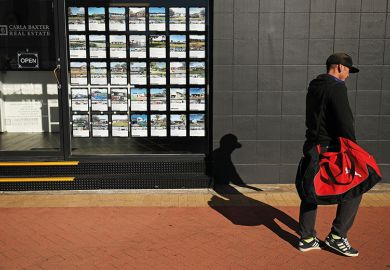Australian graduate debt will soar by A$5.3 billion (£2.8 billion) overnight when a near-record 7.1 per cent indexation rate is applied to outstanding loan balances on 1 June.
Inflation data published on 26 April confirmed that the annual hike in accumulated student borrowings would be the biggest since 1990 in proportional terms, and around double the previous record in absolute terms. It will push outstanding debt under the Higher Education Loan Programme (Help) to about A$80 billion, even before the borrowings of some 400,000 new students are factored in.
This year’s inflationary hike will exceed the combined indexation top-ups from the first 23 years of the loan scheme, raising average graduate debt from about A$24,770 to A$26,530.
People on annual salaries of less than A$62,739 – about two thirds of average full-time earnings in Australia – will find themselves more in debt than they were 12 months ago, despite making a year’s repayments.
Greens education spokeswoman Mehreen Faruqi said that more than three million Australians would confront a “debt avalanche” on 1 June. “Nurses, teachers and other essential workers face the double whammy of low wages and ballooning student debt,” she said.
Dr Faruqi said people beginning university courses were unaware that they would “end up in a debt spiral” because student loans were badged as “interest-free”. She said shops marketing their wares in similar terms would “not get away with” annual inflationary mark-ups.
Dr Faruqi’s bill to remove indexation on student debts appears unlikely to succeed after a Senate committee last week recommended that it be rejected. “Discussions around the affordability of the higher education system [should] be continued within the Universities Accord process,” the committee’s report said.
Treasurer Jim Chalmers had already signalled government unwillingness to change what he described as an “ordinary indexation” arrangement. “The repayments go up when your salary goes up,” he told ABC. “That is what determines how much you pay back. That is how the system works.”
Universities Australia reiterated the message after the release of the new inflation figures. Chief executive Catriona Jackson said that, although cost-of-living increases were “hitting graduates hard”, student loan repayments were not like mortgages or grocery bills. “[They] don’t start until you earn A$48,361 and they do not increase week on week.
“Some of the recently proposed changes to the Help system would cost the taxpayer up to A$9 billion, taking money away from essential services all Australians rely on. Any changes to Help…should be carefully assessed to ensure they do not risk the policy intent, which is to remove barriers to a university education.”
Mr Chalmers said the new figures showed that the price spiral was “beginning to moderate”, with quarterly inflation at its lowest rate since 2021. This suggests that student debt indexation, which is calculated by comparing consumer price index increases between April and March with the tally from the previous corresponding period, will be lower in 2024.
University of Technology Sydney vice-chancellor Andrew Parfitt said that, although rises in living costs were worrying students, there was little evidence that graduate debt was deterring people from making the decision to study.
He said that if inflation remained high mounting student debt would “become more of a topic of conversation. But I don’t think that’s the influencer of decision-making at this stage.”
Register to continue
Why register?
- Registration is free and only takes a moment
- Once registered, you can read 3 articles a month
- Sign up for our newsletter
Subscribe
Or subscribe for unlimited access to:
- Unlimited access to news, views, insights & reviews
- Digital editions
- Digital access to THE’s university and college rankings analysis
Already registered or a current subscriber?








